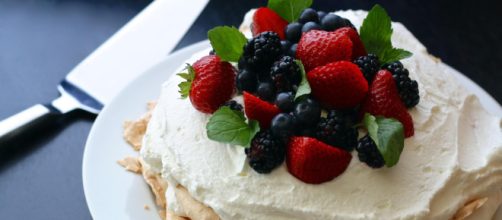Pavlova is a heavenly dessert that many might not have heard of but definitely should try once in a while if they have the spare time. Although this cloud-like treat isn't considered mainstream in the US, its recipe should be made in everyone's kitchen given how wonderfully delightful it is.
It has won many over with a texture that's crisp and chewy on the outside but soft and marshmallowy on the inside, making for one of those desserts that's out of this world. However, while many will claim it's simple to make, it's not without risk. Today, we'll be exploring exactly what it is and how one arrives at making such a heavenly dessert in their own kitchen.
What exactly is Pavlova
Pavlova is a dessert that originated either in Australia or New Zealand. Whichever the case, the dessert is popular simply given how simple it is to put it together (as long as all the rules are followed to the letter). This is a meringue-based product (stabilized egg whites + sugar whipped at a 1:2 ratio) and is baked in an oven at low temperatures.
Pavlova can be baked in molds, piped, or simply plopped out on a baking sheet. Because of its lack of ingredients, it can serve as a quicker alternative to cakes and other baked desserts. And once it's baked and cooled, it's then glazed with whipped cream and topped with fruit of one's choice.
The secret to making Pavlova
When people think about meringue-based desserts like Pavlova, it's easy for them to get the impression that it's beyond simple.
But the truth is that the meringue that forms the dessert can easily be foiled as each ingredient must be treated with care. here is a rundown of each and how they
- The egg whites - These are the star of the show--acting as the base for the Pavlova. When whipped, the whites are aerated, causing them to expand into a foam and turn stiff over time but shouldn't be allowed to turn dry or it's back to square one.
- The stabilizer - Although egg whites can incorporate air, they are also too delicate to retain it, and require stabilization while doing so. That's why an acidic ingredient like cream of tartar, vinegar, or citrus juice is added before whipping or the whites can't retain any of the air. In accordance with the formula (see the recipe below), at least half a teaspoon per four egg whites should do the trick. Also, the bowl and beaters used should be spotlessly clean or else.
- The sugar - After stabilized aeration, the sugar (white) is added to give the meringue its texture. Because this is a delicate process, the sugar must be whipped in gradually and not at once to give the whites enough time to incorporate it. It's also advised to use superfine sugar for the best results. If superfine sugar can't be procured, simply run the white sugar through a food processor until it reaches the desired consistency.
- The flavoring - Vanilla is the usual suspect but other flavors can be considered (chocolate, lemon, peppermint, etc). One teaspoon per in the formula should be more than enough for the flavor.
- The cornstarch - This is added last and is responsible for the meringue's patented marshmallowy center. However, this is folded into the base as opposed to whipping. One teaspoon here as well.
Pavlova recipe
Pavlova ingredients
- 4 egg whites
- 1 cup superfine sugar
- 1 tsp vanilla extract
- 1 tsp cornstarch
Topping Ingredients:
- 1 cup heavy cream (cold)
- 2 tbsp powdered sugar
- 1/2 tsp vanilla extract
- 1 cup fruit of choice
The directions
Pavlova Directions:
- Preheat the oven to 120°C. Line a baking sheet with a layer of parchment paper.
- Beat the egg whites and stabilizer of choice together with a hand mixer or stand mixer on medium-high speed for 5 min or until soft peaks form. Add the superfine sugar by the spoonful, stopping in between to make sure each addition is fully incorporated. Once all sugar is added, switch to high-speed and continue beating for 2 min or until glossy stiff but not dry peaks form.
- Beat in the vanilla extract for an additional min. Turn off the mixer. Fold in the cornstarch gently with a rubber spatula, avoiding deflating the meringue.
- Transfer the meringue to the baking sheet with the spatula and form a 9-inch circle, smoothing down the edges. Alternatively, you can use an equal-sized mold and/or a piping bag to form decorative shapes.
- Bake the meringue in the oven for 90 min or until the Pavlova turns firm. Do not open the oven in between baking. Turn the oven off and leave the Pavlova to cool down while still inside. It can be covered and stored at room temperature for up to 2 days if not ready for serving.
Topping Directions:
- Beat the cold heavy cream and powdered sugar together in a bowl on medium speed for 3 min or until it doubles in size. Beat in the vanilla extract.
- Spread the cream over the top of the Pavlova using a rubber spatula. Garnish with fruit of choice and serve.


